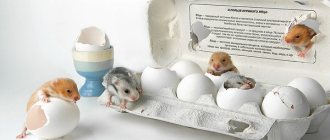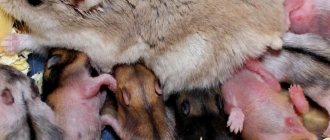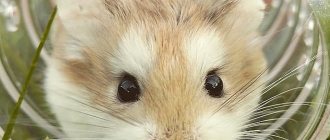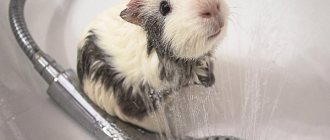Reproduction of Djungarian hamsters at home sometimes occurs spontaneously - if a couple is kept in the same cage. It is enough to make a mistake in determining the sex when buying young hamsters. It happens that they buy an already pregnant female. It’s another matter when breeding rodents is a conscious decision. Then the approach to the issue becomes professional, and the reproduction of dzungaria is strictly controlled.
How to keep a couple before mating: together or in different cages
Hamsters of this species reproduce well, and in captivity they are able to do this throughout the year. However, for this process they need to create certain conditions. So, before mating, it is better to keep the female and male in different cages, since they can show aggression towards each other - they will fight for territory. They need to be combined in one cage only for the duration of mating.
Note that peaceful coexistence of a boy and a girl in the same room is possible, but this is quite rare. If you do not have the opportunity to buy another cage, then you can place the female with the male for a while. Who knows, what if your couple will be on the list of those rare ones who live in peace and harmony. If the experiment fails, then it will still be necessary to decide to purchase a new cell. It is unlikely that you will like to put up with scratches and scraps of torn fur.
Read on for tips on choosing a cage and ball for your hamster.
You can avoid conflicts if you buy a girl and a boy at the same time and at the same time place them in a new cage. In this case, one male can even get along with several females. You should avoid placing a younger female with a male who has already been living with you for some time. In this case, war cannot be avoided.
Did you know? Experienced breeders have noticed that in a territorial war between males and females, the latter almost always win, and the males are inferior to them.
Pair selection
To start breeding Djungarian hamsters at home, it is recommended to have 1 male and 2-3 females. The choice of a breeding pair should be taken very seriously. It is better to buy hamsters from different breeders so that they are definitely not related.
At the time of purchase, the weight of rodents must exceed 35-40 g. Preference should be given to hamsters that have reached two months of age. When choosing future breeders, it is important to make sure that they are not sick. Healthy hamsters have clear eyes, shiny, beautiful fur, and dry under the tail. Such rodents are active in the evening and willingly accept treats. For successful breeding, you should choose hamsters of the same species and the same age.
Important! You cannot mate two dwarfs with tangerine or pearl color. The offspring of such parents will be born non-viable. Parents with different colors are suitable for breeding. Two individuals with classic, wild colors can be crossed.
Each rodent will need its own cage. In rare cases, females may cohabitate with each other if they have been raised together since birth. Such rodents can be housed in one cage, but each one must have its own house. The male is kept separately - Djungarian hamsters reproduce very quickly if this process is not controlled.
Some breeders divide the common home into parts with lattice partitions so that individuals of different sexes can see each other. You can put 2 separate cells next to each other. At the same time, hamsters get used to the smell of their relatives and do not fight. Thanks to this proximity, it is easier to determine when the hamster is ready to breed.
At what age do jungarians begin to mate?
Puberty in hairy hamsters occurs at 1-2 months. It is better to pair with a younger male and an older female. Ideally, the boy will be 3 months old, and the girl – 4. It is at this age that the female will be ready to take care of the offspring, and childbirth will become safe for her body.
If you still do not have information on how to determine the sex of hamsters, then you can do this already a month after birth. To do this, measure the distance between the animal's anus and genitals while lying on its back. If it is 0.5-1 cm, and in the center of the abdomen there is a small bulge - the male gland, then this is a male. Already at 2-3 months you will be able to see the testicles. If the distance is less than 0.5 cm, and there are 2 rows of nipples on the stomach, then it is a female. The female is also usually slightly larger than the male.
Important! A month after birth, females and males must be placed in different cages.
When is mating acceptable?
If you want to get offspring from your pets, you should know how hamsters mate and what you need to pay special attention to. The maturation features of the rodent's body allow it to begin reproduction at the age of 4-6 weeks. In Djungarian individuals, puberty often occurs before 3 weeks. However, you should not bring a male and a female together at such an early age. For females, this is fraught with the following complications:
- Rickets.
- Disturbances in the functioning of the genitourinary system.
- Cannibalism.
Rickets and complications in the functioning of the genitourinary system are caused by the fact that at an early age the entire organism as a whole is actively developing. If the body has not had time to form, and pregnancy has occurred, all efforts are spent on providing the cubs with everything they need, while the female herself is left without nutrients.
Cannibalism is one of the most common problems, which is often caused not only by early birth. It also often occurs due to stressful situations, when the female feels threatened, or if the animal is unwell and unable to feed its young.
The most suitable age for mating is 4-6 months. It is advisable to meet this deadline, since late breeding (after 6 months) for the pet can result in complications.
Breeding hamsters at home must be carefully controlled. In no case should mating be allowed to occur earlier than 4 months after the previous pregnancy. This is necessary so that the female:
- fully recovered after childbirth;
- fed the offspring;
- gained strength and restored all the substances necessary for the body before a new pregnancy.
At the age of one year, a hamster may completely lose the ability to bear and feed babies. In the case of males, everything is much simpler - they can mate starting from the 5th week of their life, and their ability to produce offspring remains throughout their lives.
How to understand that a female needs to be introduced to mating
She will indicate that the female is ready to mate by unusual behavior. Once every 4-5 days, she will often raise her tail, arch her back, and secrete a strong-smelling substance. This is how the female’s sexual activity will manifest itself, which, as a rule, coincides with the follicular stage of the sexual cycle. Scientifically, this process is called estrus, popularly called estrus. Estrus usually begins in the evenings and lasts from 4 hours to a day. At this time, the female becomes favorable to the male, so it is best now to unite them in one cage.
Sexual intercourse in hamsters
It is not customary for domestic rodents to have long foreplay; usually, after a short introduction and sniffing, they immediately get down to business. And why wait, because their life is so short!
So, you left your pets alone in a secluded place. If the female is completely ready for mating, then the male piles on top of her and hugs his girlfriend around the waist with his tiny paws. The submissive bride does not object, she leads the seed quietly and meekly, but Don Juan is very active! The mating process for representatives of the Dzungarian breed and other dwarfs lasts no more than 5 minutes; Syrians usually inseminate a hamster longer.
If a couple consists of a very calm girl and a small active boy, they may have intercourse several times throughout the night. In such cases, in the morning the male falls exhausted. Such a vigorous sex life can undermine the health of a hamster and even temporarily drive it into stupor.
In the photo, Roborovsky’s gentleman hugged his chosen one:
Sometimes problems arise during or before sexual intercourse. You need to know when it is better to place a couple in different cages.
What conditions need to be created for successful reproduction?
To encourage hamsters to mate after uniting them under one roof, you should place a lamp in the immediate vicinity of the cage and direct the light from it into the cage. In this case, the animals will look for a dark corner in their home. This will certainly bring them closer.
The best option for mating would be a separate cage, carrier, or box . This way you can avoid conflict. If this is not possible, then the female is placed with the male, and not vice versa.
The mating cage should be spacious. The room temperature is not lower than 20°C and not higher than 25°C. The cage should be installed in a secluded place where there are no drafts, noise, heating devices, and away from other pets. It is advisable to remove all gaming accessories from it.
Find out more about hamsters: what breed of pet hamster to choose, how long do hamsters of different breeds live, how to train a hamster to respond to its name.
Do not abandon animals immediately after joining without supervision. If a serious fight breaks out, they will need to be seated. You can leave them alone only if it is clear that they like each other.
Since after conception the female will begin to build a nest, she needs to put materials in the cage - rags, cotton wool, clean paper, hay. Placing newspapers in the cage is strictly prohibited.
Offspring of Djungarian hamsters
A litter can contain from 1 to 11 cubs at a time. The mother feeds them with milk for about 19 days, then the babies can be resettled . Hamsters are born completely bald, blind and deaf. Among the senses, newborns have only smell, which helps them not to die of hunger. With proper care of the mother, the cubs do not make any sounds, and the pet owner may not even realize that there is already more than one hamster in the cage until she begins to crawl out of a secluded place on her own.
How do Djungarian hamsters mate?
Sexual intercourse among Djungarians lasts on average about 5 minutes. In general, the process of addiction and familiarization occurs within 20-30 minutes.
Djungarian hamsters usually mate in the dark. The male approaches the female several times with short breaks.
A couple should be placed in different cages when they have lost interest in each other. However, keeping them together for longer than 45 minutes is not recommended.
Do not worry if after mating the male lies down, barely breathing - sexual intercourse requires a lot of energy, so the animal needs time to recuperate. After mating, both the female and the male should be well fed with their favorite treats in the feeder.
Be prepared that it will take several matings to conceive . If 5 days after the first mating the hamster comes into heat again, the mating will need to be repeated. If estrus did not occur, and after some time the girl began to gain weight (usually the tummy becomes slightly noticeable after 10 days), then conception was successful.
Video: reproduction of Djungarian hamsters
What to feed a pregnant female
A pregnant hamster needs to create comfortable conditions, ensure complete peace and absence of stress. Remember that stressful situations can have a detrimental effect on the offspring, even to the point of a distraught mother devouring her children.
The hamster should also be provided with good nutrition. At this time, her diet should contain a lot of fruits, vegetables and products containing protein, which is so necessary during the development of the offspring in the womb . The latter include:
- egg white;
- chicken meat (boiled);
- baby food with meat;
- dairy products.
Learn more about hamster nutrition.
Also, at this moment the female urgently needs to replenish her body with minerals. To do this, place a chalk stone in the cage.
Important! Good nutrition for the mother will guarantee that she will not bite the babies to death.
.
Pregnancy
It is quite difficult for an ignorant person to determine whether a Djungarian hamster is pregnant. It is almost impossible to understand that the crossing was successful and conception occurred in the first 10 days.
The Djungarian hamster's belly does not increase until the middle of gestation, and the pet behaves as usual. But an attentive owner can still determine pregnancy by the following signs:
- Decreased activity. The hamster moves more smoothly, carefully, and stays in the house more often, even at night.
- Increased appetite. Dzungarik eats more than usual.
- In the second half of pregnancy, the female begins to build a nest for her future offspring. She fusses and drags building materials - paper, napkins - into one of the corners of the cage or into the house. It is important to make sure that she has all this in sufficient quantity.
- Towards the end of the pregnancy, the Djungarian hamster gains a little weight. His belly is rounded, and this is already visible to the naked eye.
Feeding and caring for a hamster during pregnancy
Pregnancy lasts about 21 days. About a week before the end of the gestation period, it is necessary to do a general cleaning of the cage - replace the filler, wash and disinfect the tray, feeder and drinking bowl. Then such an opportunity will arise only when the little Djungarian hamsters open their eyes.
Attention! During the breeding season, the female is sensitive to stressful situations. She should not be disturbed and protected from loud and harsh sounds.
It is important to feed your hamster properly. During the breeding season, the dwarf should receive more protein and vitamins. In addition to the grain mixture, he should be given low-fat cottage cheese, egg whites, sprouted grains and fresh herbs. The diet must include vegetables - carrots, pumpkin, cucumbers, cauliflower.
How many hamsters are born to Djungarians?
A female Djungarian hamster is maximally capable of bearing 18 babies. Usually one individual has from 5 to 9 children.
Under no circumstances should you interfere with the birth process. It is better not to approach the cage at all, so as not to scare off the female. Childbirth lasts from 1 to 2 hours. The intervals between babies coming out are on average about 15 minutes.
Newborns are born tiny, bald and blind. Babies' eyes open after 2 weeks.
Childbirth
The approach of childbirth is indicated by a lack of appetite and increased thirst in the female. She almost never leaves the nest, as she feels that the cubs will soon be born.
Childbirth in Djungarian hamsters begins on the 20-22nd day of pregnancy. This happens mainly at night. There are 4-6 cubs in a litter. During childbirth, females do not need outside help. Complications are rare.
When contractions begin, the hamster sits on her butt and bows her head over her belly. With the help of her teeth and front paws, the female helps each cub exit the birth canal. She ruptures the membranes, gnaws the umbilical cord and licks the babies. Childbirth lasts 1.5-2 hours. The kids come out at intervals of 10-15 minutes.
Attention! The hamster eats non-viable or stillborn babies. There is nothing wrong with this - this is how the mother cleans the nest of biological waste and takes care of feeding healthy jungarians.
Care of offspring
After giving birth, the mother needs rest - at least for a week. After this time, she will again be ready to mate and conceive.
A nursing mother will need good nutrition and a constant supply of clean water . It is advisable to purchase special food at a pet store so that the hamster’s breast milk is as rich as possible in the vitamins and minerals necessary for the normal development of healthy offspring.
The cage where the babies are located must be spacious - at least 50 by 30 cm. The temperature in the room where the babies live must be maintained at 21-25°C . The house with newborns should be in a shaded, quiet place.
Thus, the owner must create all favorable conditions for the new mother, but not interfere in the process of caring for the babies.
If the mother nevertheless abandoned the cubs, then you need to try to feed them yourself. For this you will need baby formula. However, the chances of survival for abandoned babies are low.
Problems when breeding hamsters
Cubs can be born dead, die during childbirth, or become victims of a negligent mother.
Dead cubs can be born to a healthy female for the following reasons: infection, disease, poor nutrition, poor diet during pregnancy, lack of essential vitamins and microelements in food.
Often a pregnancy, especially the first one, ends with the hamster eating the babies. There are quite a few reasons for this:
- improper diet during pregnancy, in particular, insufficient amount of animal protein in the diet;
- the failed mother is too young;
- stress or fear after childbirth;
- in the cage where the hamster gave birth, there is a male who poses a threat to her babies, and therefore she directs aggression either at the male, and if this fails, then at the babies;
- regulation of the number of offspring (a female hamster has 5 or 6 pairs of nipples, and so many babies can be born that she will not be able to feed them all);
- if the baby was born weak, sick or with a birth defect;
- if a person picks up a small hamster in his arms in the first week after giving birth, which causes the baby to develop a foreign smell.
There is also a situation when the cubs die due to the excessive care of the mother, when, worrying about the safety of the offspring, she constantly moves the cubs in search of a safer place.
Babies can be born completely healthy, and yet die in the first week of life. This may happen due to the fact that the female is not able to fully feed her babies (insufficient amount of milk or its complete absence).
Poor nutrition, lack of drinking water, heat in the room where the cage with a pregnant female is located and stress can cause the death of a hamster just before giving birth or at the very beginning of feeding newborns. This condition is often called hamster pregnancy toxicosis. Signs of pregnancy toxicosis in females: lack or decreased appetite, dull and tousled fur, muscle spasms, and drooling.
Attempts to cure this problem are unsuccessful in most cases. Prevention is important here - providing the most comfortable conditions for a pregnant hamster (constant humidity and air temperature, absence of drafts, peace and quiet, as well as a properly formulated diet and access to fresh, clean water).
www.krasnouhie.ru
Is it possible to pick up small jungarians?
Experienced breeders do not advise touching or picking up babies until they reach two weeks of age. Also, until this time, it is worth climbing into the cage with your hands less often, only to carry out the necessary manipulations of replacing water and providing food. The litter is not changed at this time.
The most popular of all types of domestic hamsters is the Syrian; families with children love it.
The fact is that any careless actions can scare away the mother, and in this case she will stop fulfilling her parental responsibilities. There is a big risk that she will stop feeding the children if she smells someone else's smell on them.
Maintenance and nutrition
Pet cage
| Cell | Price |
| Ferplast Hamster Duo rodent cage | RUB 3,800 |
| Criceti 9 Princess 9 for hamsters 46×29.5×23 cm | RUR 1,851 |
| Ferplast Ferplast Olimpia 46×29.5×54 cm | RUR 4,355 |
| TRIOL Triol YD415 340x280x250 mm | RUB 1,137 |
| TRIOL Triol 1403 580x320x320 mm | RUB 2,314 |
Despite the modest size of the animal, the cage should be relatively large. The minimum dimensions are 55x30 cm. In some cases, in order to avoid unnecessary injuries, a single-tier cage is recommended. Instead of the usual version of rods, you should pay attention to cage options with plastic inserts and closed dunes.
At home, unfortunately, Djungarians can only survive in a cage because they are very picky about food and external conditions, this is not a Roborovsky hamster, which can also fight back!
The presence of pipes and various tunnels, labyrinths and passages will help the animal quickly feel the homely atmosphere. Indeed, in nature, hamsters constantly dig labyrinths and tunnels for themselves: this is important for them in terms of life and personal safety.
The cage should be in a quiet place, protected from drafts and direct sunlight. A house in a cage must be provided for the animal’s privacy. For the Dzungarian species, the optimal size of the house is 10 cm. You can purchase the simplest design without windows and bottom.
A thick layer of filler is poured onto the bottom of the cage: the thicker it is, the better for the rodent. You should choose cellulose or corn options. Rags, napkins or paper towels will help your hamster build his nest. It is important that the fabric is white, without dyes.
The main equipment for the cage are the following household items:
- A house where he can easily escape if he needs privacy.
- Lazy. They can be of various shapes and heights so that the rodent does not get bored.
- A specialized toilet designed for small rodents.
- Bedding made of compressed sawdust.
- A drinking bowl with a volume of at least 50 ml. It is best to purchase an automatic water supply option.
- Place of animal hygiene in which sand must be poured. It must be dry and clean.
An alternative to a standard cage, in the case of Djungarian hamsters, can be an aquarium. Narrow containers for keeping rodents are not suitable due to poor ventilation, so you need to choose the standard rectangular option. Otherwise, bacteria that are harmful to the animal may multiply in the aquarium.
Pet sports area
To maintain an optimal level of health, the animal needs to cover a distance of 10 km per day. You can help your animal maintain this activity using a running wheel. The diameter for a dwarf rodent should not be less than 16 cm. There should be no crossbars, and the distance between the rods should be such that the pet’s paws do not fall into it when running.
In addition to the wheel, a number of owners purchase balls for walking. With its help, your pet can calmly walk around the apartment without touching wires or chewing furniture. Additional devices can include labyrinths, tunnels and obstacle courses.
Eating area
The best option for a rodent feeder would be a deep metal container. It will not roll over and is easy to clean. In the case of a closed feeder, it is hung on the walls or bars of the cage.
Additional accessories
Sometimes a carrier cage may be needed. The hamster can also be placed in it when cleaning the cage.
It is better to feed animals in the evening, when they begin to become active. The drinking bowl in the cage needs to be changed regularly. Spot cleaning should be done daily. This procedure includes changing the filler, as well as yesterday’s food with fresh food.
Hamsters themselves organize a toilet using fresh litter; they are quite clean.
Despite the need to maintain cleanliness, spring cleaning is stressful for a hamster. Therefore, washing the cage should not be done more than once a week. Washing should be done with a clean sponge and fragrance-free soap. It is important to treat all accessories during cleaning and then wipe dry. The drinking bowl also needs to be disassembled and washed thoroughly.
Cage cleaning should be carried out according to schedule. Even if the cage is heavily contaminated, chemicals should be avoided. In order to remove stains from waste residues, you can use vinegar, applying it to the epicenter of contamination for 15-20 minutes, then remove it with a damp cloth.
Hamsters are very sensitive animals. Especially their psyche can be shaken by general cleaning of the food reserves that they are actively creating. Cleaning too often can lead to stress for the animal. Therefore, you can reduce the risk of psychological trauma by removing only spoiled varieties of food.
Communication process
Djungarian hamsters are independent and rarely make contact with their owner on their own. Some individuals may begin to bite the owner while attempting contact. You need to accustom your animal to handling gradually, with less stress for both parties. Don't expect too quick results. If there is no progress, you need to contact a veterinarian; perhaps, communication with a person is physically unpleasant due to the animal’s hidden ailments.
It is also worth remembering that if there is no contact with the pet for 1-2 weeks, it will go wild again and you will have to start the procedure again.
The hamster is a nocturnal animal, so during the daytime it is lethargic and passive. But in the early evening you can accustom the animal to communication. Some individuals are given basic training. In order for the owner to sleep comfortably at night, you can use earplugs, or slightly adapt your regime to suit your pet.
Where is the best place to keep it?
The Djungarian hamster must be kept in a spacious cage: the animal is quite mobile and needs a lot of space to play. If the cage is too cramped, the hamster will be in a constant state of stress, which will lead to illness and early death.
The cage for Djungarian hamsters must meet the following requirements:
- the cage bars should not be galvanized; its dimensions should be at least 30 by 50 centimeters. If there is no cage, the hamster can be kept in a spacious aquarium. The aquarium must have low walls, otherwise, due to poor air ventilation and dampness, colonies of bacteria and fungi will appear in it, which will affect the health of the hamster;
- sand or small sawdust are suitable as bedding. Cotton wool, newspapers and scraps of fabric should not be placed on the floor of the cage: they can harm the health of the animal. Particles of thread and cotton can get into the respiratory tract and cause irritation, and newspapers are printed using toxic inks;
- the cage should contain branches, large roots and other objects that the Djungarian hamster can climb;
- in nature, Djungarian hamsters live in burrows, so the animal must have a house that can be attached to the wall of the cage;
- the cage must be equipped with a running wheel, the diameter of which depends on the size of the hamster;
- The cage must be equipped with a drinking bowl with a volume of 50 ml. The water in the drinking bowl is changed daily. It is necessary to ensure that mold does not appear on the walls of the drinking bowl;
- The cage feeder is selected depending on the size of the pet. Its length can range from 3 to 8-9 centimeters. The feeder should be stable and not too deep.
Additionally, you can buy a bathing suit for fine sand, in which the hamster will clean its fur.
It is important that your hamster always has a chalk stone in his cage to wear down his teeth. You can replace the chalk stone with a small birch block.
Djungarians have a high chance of developing diabetes, so their diet should not contain foods rich in sugars (honey, fruits, vegetables).
Communication
Djungarian hamsters communicate with their owners very willingly. They quickly get used to being handled and rarely show aggression. In order for the pet to trust its owner more, immediately after purchasing a Djungarian hamster, you need to pick it up more often and talk to it in a quiet, calm voice.
When adapting a hamster to new living conditions after purchase, you should touch it only with thoroughly washed hands, which are not covered with cream or eau de toilette. This will allow the animal to quickly get used to the natural smell of the owner. In addition, the strong smell of cosmetics can cause allergies in the Djungarian hamster.
Nutrition
Diet
Grain mixtures often serve as the basis of the diet. Animals have a well-developed metabolism, so they need a sufficient amount of food. In order to maintain your pet’s health at the required level, it is important to purchase food from trusted manufacturers. Fresh vegetables and occasionally protein foods will help diversify the diet.
The myth that hamsters eat everything is fundamentally false . Before creating an animal’s diet, you should study the list of permitted and prohibited foods.
Diet
| Name of food | Price |
| VERSELE-LAGA Crispy | 239 RUR |
| Brava grain mixture with fruits and vegetables | 55 RUR |
| Treat for rodents Prestige | RUR 219 |
| FIORY Criceti for hamsters | RUR 233 |
| Mr.Alex Assorted cereal stick | 82 RUR |
| Mr.alex вasic Buckwheat | 129 RUR |
| Padovan Food Padovan Grandmix criceti | RUR 322 |
| Fiory Fiory food for hamsters Classic | RUR 184 |
The basis of the diet should be balanced dry food for Djungarian hamsters. Additionally you can give :
- seeds and nuts (except almonds);
- dried fruits;
- sprouted wheat grains (especially in the off-season to prevent vitamin deficiency);
- small amounts of fruits and vegetables.
Two to three times a week you should add protein foods to your diet: boiled egg whites, cottage cheese, boiled low-fat fish.
Sick hamsters and pregnant hamsters can be given baby food prepared in water.
Under no circumstances should you give your Djungarian hamster the following foods:
- spices (salt, pepper, sugar);
- sweets (chocolate, cookies, ice cream);
- citrus;
- mushrooms;
- sausages and sausages;
- branches of coniferous trees.
The hamster should be fed twice a day: morning and evening. The serving size depends on the animal’s needs, its age and activity. It is advisable that the food be a little more than the hamster needs.
Before adding fresh food, you need to remove any leftovers from the previous meal and thoroughly wash the feeder.
How many individuals are best kept in one cage?
You cannot keep several hamsters in one cage. In nature, Djungarian hamsters lead a solitary lifestyle, so they will perceive another individual on their territory as a competitor. When kept together, the animals will experience chronic stress, and during a fight they can seriously injure and even kill each other.
You can keep hamsters in the same cage only if they grew up together. However, even in this case, conflicts over territory may arise between two individuals.
When can you give away hamsters after birth?
Hamsters develop very quickly, so already at the age of one month they can be given into the wrong hands. Until the 21st day, they should be close to their mother. Then, no later than the 28th day, they should be removed. They must live in a separate cage for some time before being sold. The new owner should be given some bedding from the old cage and food so that the babies quickly adapt to an unusual place - a familiar smell and familiar food will reduce stress.











